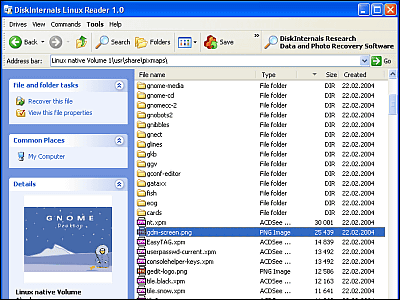
- #DISKINTERNALS LINUX READER FREE FOR FREE#
- #DISKINTERNALS LINUX READER FREE INSTALL#
- #DISKINTERNALS LINUX READER FREE PRO#
- #DISKINTERNALS LINUX READER FREE SOFTWARE#

#DISKINTERNALS LINUX READER FREE FOR FREE#

Unlike Linux Reader, Ext2FSD also supports ext4 partitions, which means you’ll be able to access all your data easily.
#DISKINTERNALS LINUX READER FREE SOFTWARE#
#DISKINTERNALS LINUX READER FREE PRO#
That latter is called Linux Reader Pro and comes with a few additional features. The software is available both as a free and paid subscription. With Linux Reader, you can mount the Linux partitions in Windows and transfer data from one platform to the other. So, here are the best tools to access and recover data from Linux ext2 and ext3 file systems on Windows.ĭiskInternals Linux Reader is the most popular Windows application you can use to read Linux file systems on Windows OS. Part 3: Best Tools to Access Linux Ext2 Ext3 on Windows Similarly, if you’re working on an Excel sheet in Windows and want to access a few reports from the Linux directories, it would be better to access Linux Ext2 and Ext3 directly. For instance, if you’ve downloaded a file in Linux and currently logged into Windows OS, it would be much easier to access it within the same environment. The truth is there are several situations when you may need to access the Linux file systems on Windows. Part 2: Why Do You Need to Access Linux Ext2 and Ext3 on Windows?
#DISKINTERNALS LINUX READER FREE INSTALL#
That’s why it’s crucial to install a dedicated program to access the ext2 and ext3 file system in Windows. Unlike Linux, Windows doesn’t have built-in support for the Linux file system. Unfortunately, on a dual boot setup, you won’t be able to access these file systems within the Windows environment.

For instance, the Ext2 file doesn’t feature journaling whereas Ext3 supports the journaling functionality.Īpart from this, both these file systems have similar features including the maximum individual file size (16GB to 2 TB) and the overall file system size (2TB to 32 TB). While both these file systems resemble a lot of properties, there are a few key differences that separate them from each other.

Part 1: What’s the Different Between Linux Ext2 and Ext3?īoth Linux Ext2 and Ext3 are dedicated file systems that are used to store and manage data on a Linux machine. Part 3: Best Tools to Access Linux Ext2 Ext3 on Windows.Part 2: Why Do You Need to Access Linux Ext2 and Ext3 on Windows?.Part 1: What’s the Different Between Linux Ext2 and Ext3?.


 0 kommentar(er)
0 kommentar(er)
